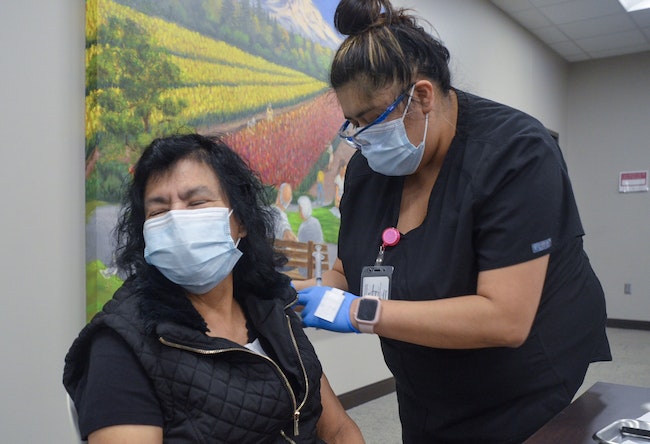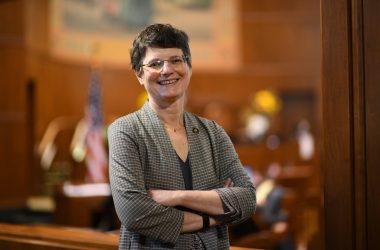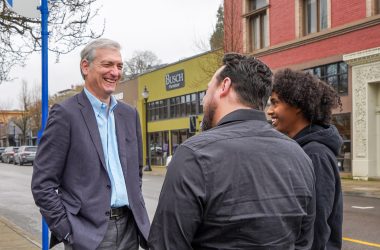
Florinda Velasquez, 74, prepares to receive her second dose of Covid vaccine from medical assistant Ana Barcenas at Lancaster Family Health Center in southeast Salem on Thursday, March 4 (Rachel Alexander/Salem Reporter)
Latino health organizations say Oregon officials are failing to get enough vaccines to the communities they serve, jeopardizing the health of people who are already disproportionately affected by the pandemic.
Even with expansions in eligibility over the past month, Latinos in Oregon account for less than 6% of those vaccinated to date, despite making up 13% of the state’s population and one-third of Covid cases where ethnicity is known.
Marion County has vaccinated a larger share of Latinos, which the county health department and local nonprofit leaders credit to substantial outreach work done by Latino organizations locally. Even so, Latinos make up 27% of the county’s population and just 14% of people who have received at least one shot.
“What we are left with today is high infection rates in the Latinx community, paired with low vaccination rates,” said Tony DeFalco, executive director of the Latino Network, during a news conference Thursday. “Our community is at greater risk than ever before. We have over-representation in the service sector of the economy. And as reopening occurs, our community members are at great risk.”
The proportion of vaccines going to Latinos has increased slightly since early March, when just 4% of vaccines statewide and 10% in Marion County had gone to Latinos.
State health officials said then that the eligibility criteria accounted for the lower vaccination rate. Oregon seniors, who made up the largest number of people eligible, are whiter than the state’s population as a whole.
But weeks after farmworkers became eligible for shots and the state allowed community health centers serving mostly Latino and immigrant communities to vaccinate all their patients, vaccination rates are still far from equal. Marion and Polk counties began vaccinating agricultural and food processing workers March 22, and those groups became eligible statewide March 29.
Levi Herrera-Lopez, executive director of Mano a Mano in Salem, said Marion County’s relative success compared to other parts of the state is thanks to events targeting Spanish-speaking communities and farmworkers put on by organizations like his and the Interface Network, which has helped staff a weekly drive-through vaccine event in Woodburn.
“A lot of the actual dirty work of doing these events has been done by community based organizations that are generally overwhelmed with many other challenges,” he said.
He said the county health department has been an important partner and state and local money has helped. But those funds also came late, he said. Until March, state money for community groups like his was focused more on Covid prevention and testing than on supporting vaccination outreach.
Marion County has a weekly meeting with community and nonprofit organizations to help guide the vaccine rollout and is launching an advertising campaign in Spanish showcasing local leaders who have gotten the shot, health department spokeswoman Jenna Wyatt said.
That’s intended to address people who have concerns the vaccine isn’t safe or haven’t received accurate information about it, something Herrera-Lopez said remains a challenge.
Wyatt said until vaccine supplies increase across the board, shortages will remain. Marion County has tried to direct doses to ZIP codes hit hardest by Covid, particularly the Woodburn area, and works with community groups to host events for farmworkers. Those events typically fill up, Wyatt said.
The Oregon Health Authority pointed to similar outreach efforts in response to a question about how the state is seeking to equalize vaccination rates, including upcoming events targeting agricultural workers. In a statement, the health authority said they are continuing to review vaccine allocations to make distribution more equitable.
“Oregon and its local and health care partners can do better. We welcome input from the community, and we look forward to continuing to work with organizations and health systems on the ground in every corner of the state,” the health authority said.
Salem Health said they have at least one interpreter onsite at each of their vaccine clinics and have targeted mobile vaccine clinics across the region to hard-to-reach communities and those with transportation barriers, including agricultural workers. They’ve also worked with local Latino groups in planning their efforts, spokeswoman Lisa Wood said.
During the Thursday news conference, leaders from the Latino Network and other Oregon health organizations said specific barriers keep many Latinos from seeking vaccination at mass sites like the state fairgrounds in Salem and the Oregon Convention Center in Portland.
Those include concerns about the presence of police or members of the military, as well as transportation difficulties and a lack of familiarity with the locations.
They said communication from health agencies needs to make clearer that vaccines are free to all, even those without insurance, and that anyone can get a shot regardless of immigration status.
While they acknowledged that Marion County has a lower racial disparity in vaccine administration than many other parts of Oregon because of work with community organizations, they said the gap is still concerning.
“That’s a race to the bottom,” said Marcus Mundy, executive director of Oregon Coalition of Communities of Color. “That’s nothing to celebrate. You have to match up with the population. How can we be excellent in all counties for this population?”
Contact reporter Rachel Alexander: [email protected] or 503-575-1241.
BE PART OF OUR TEAM FOR SALEM’S BENEFIT: Accurate local information is vital for any community and that’s harder to come by in this day of “anyone can post anything” to social media. People in communities without trained journalists working for them don’t have accurate, trusted information. Help Salem avoid that fate – join in putting fuel in the tank of Salem Reporter to keep it growing, going strong. Here’s how:
SUBSCRIBE: A monthly digital subscription starts at $5 a month.
GIFT: Give someone you know a subscription.
ONE-TIME PAYMENT: Contribute any amount and you support giving the people of Salem local news otherwise missing. (You can also mail your contribution: Salem Reporter, 72585 Middle Fork Lane, Bates OR 97817)

Rachel Alexander is Salem Reporter’s managing editor. She joined Salem Reporter when it was founded in 2018 and covers city news, education, nonprofits and a little bit of everything else. She’s been a journalist in Oregon and Washington for a decade. Outside of work, she’s a skater and board member with Salem’s Cherry City Roller Derby and can often be found with her nose buried in a book.









